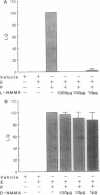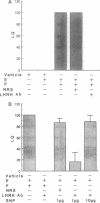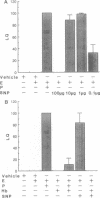Abstract
Nitric oxide (NO), an active free radical formed during the conversion of arginine to citrulline by the enzyme NO synthase (NOS), mediates vasorelaxation, cytotoxicity, and neurotransmission. Neurons containing NOS (NOergic) are located in the hypothalamus. These NOergic neurons control the release of several hypothalamic peptides. Release of NO from these NOergic neurons stimulates pulsatile release of luteinizing hormone-releasing hormone (LHRH) in vivo and LHRH release in vitro. LHRH not only induces LH release, which induces ovulation, but also facilitates female sexual behavior. Sexual behavior can be induced reliably in estrogen-primed ovariectomized female rats by progesterone (P). This behavior consists of proceptive behavior to attract the male and the assumption of a clear characteristic posture, lordosis, when mounted by the male. To ascertain the role of NO in the control of sexual behavior in female rats, an inhibitor of NOS, NG-monomethyl-L-arginine was microinjected into the third cerebral ventricle (3V) of conscious, ovariectomized, estrogen-primed rats with indwelling cannulae. NG-Monomethyl-L-arginine (10-1000 micrograms) prevented P-facilitated lordosis when administered intracerebroventricularly into the 3V, 20 min prior to the 3V injection of P. NG-Monomethyl-D-arginine, which does not inhibit NOS, did not inhibit lordosis under the same experimental conditions. Microinjection into the 3V of sodium nitroprusside (SNP), which spontaneously releases NO, facilitated lordosis in estrogen-primed rats in the absence of P. The facilitation of lordosis induced by either P or SNP was prevented by intracerebroventricular injection of hemoglobin, which binds NO. Lordosis facilitated by P or SNP was blocked by injection of LHRH antiserum into the 3V. The results are interpreted to mean that the P-facilitated lordosis response is mediated by LHRH release. Furthermore, since NO release from SNP also facilitates lordosis in the absence of P and this response could be blocked by LHRH antiserum, we conclude that P brings about the release of NO, which stimulates LHRH release that facilitates lordosis. Thus, the results indicate that NO induces LHRH release and that LHRH then plays a crucial role in mediation of sexual behavior in the female rats.
Full text
PDF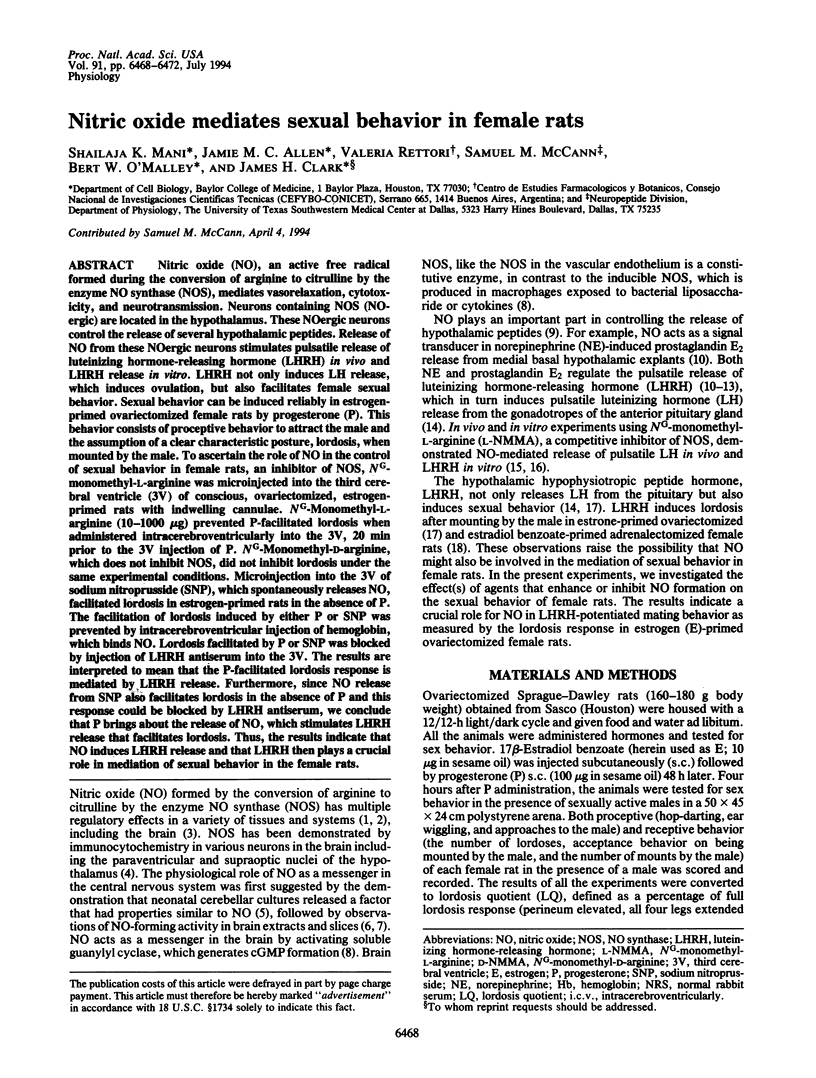
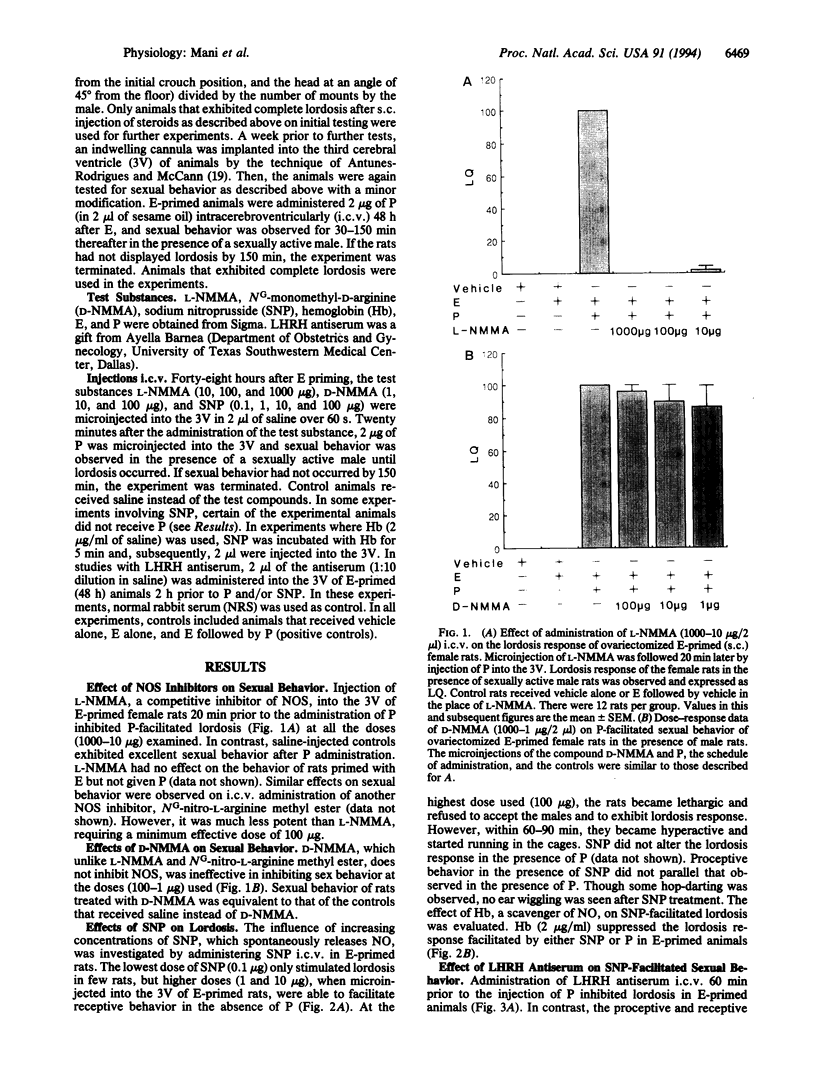
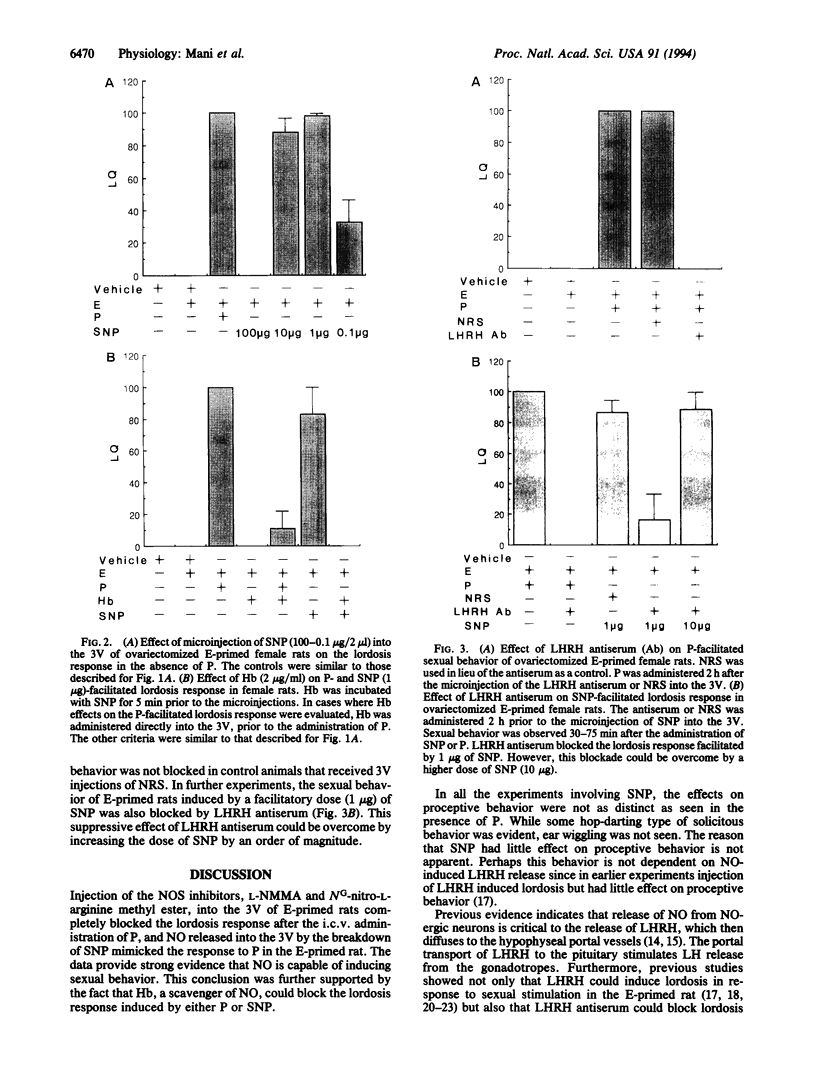
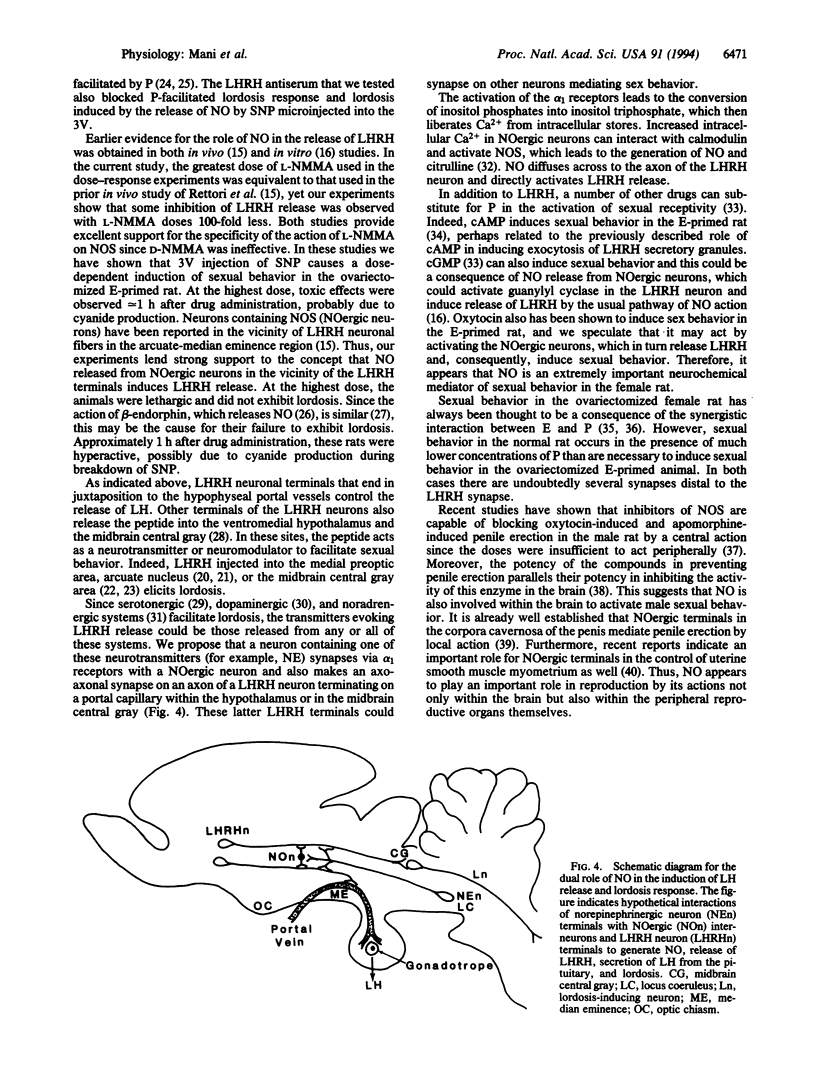
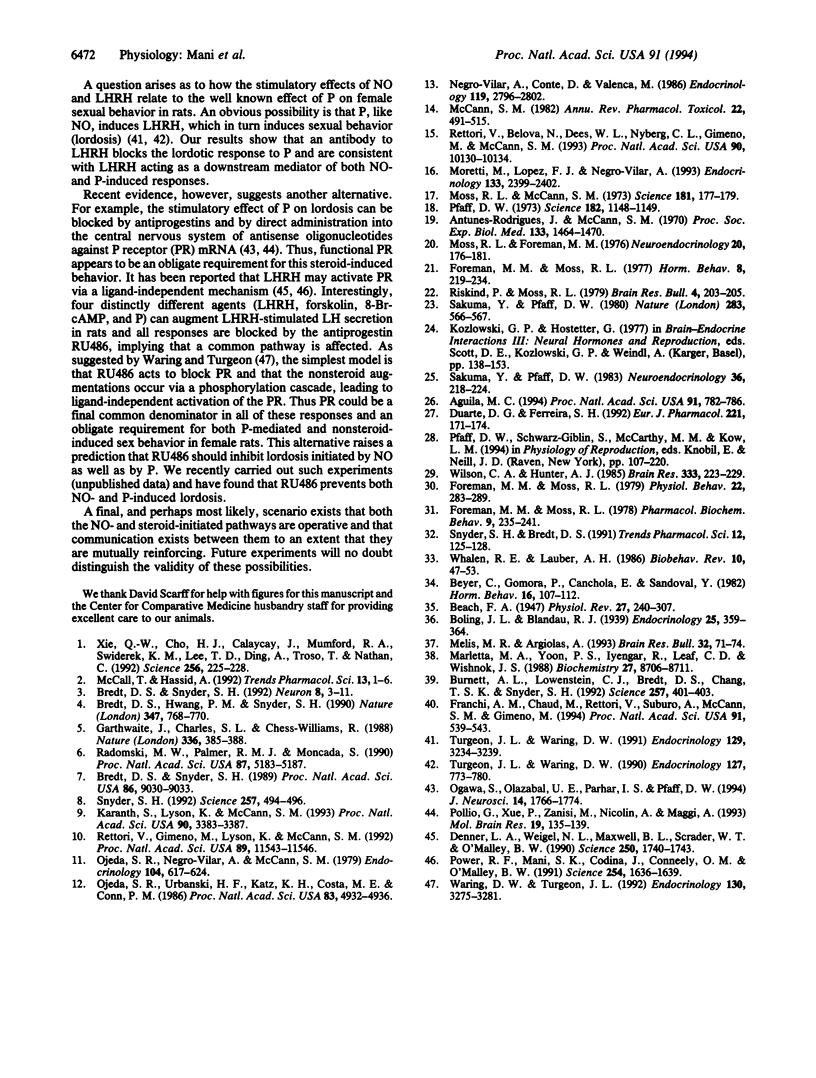
Images in this article
Selected References
These references are in PubMed. This may not be the complete list of references from this article.
- Aguila M. C. Growth hormone-releasing factor increases somatostatin release and mRNA levels in the rat periventricular nucleus via nitric oxide by activation of guanylate cyclase. Proc Natl Acad Sci U S A. 1994 Jan 18;91(2):782–786. doi: 10.1073/pnas.91.2.782. [DOI] [PMC free article] [PubMed] [Google Scholar]
- Antunes-Rodrigues J., McCann S. M. Water, sodium chloride, and food intake induced by injections of cholinergic and adrenergic drugs into the third ventricle of the rat brain. Proc Soc Exp Biol Med. 1970 Apr;133(4):1464–1470. doi: 10.3181/00379727-133-34713. [DOI] [PubMed] [Google Scholar]
- Beyer C., Gomora P., Canchola E., Sandoval Y. Pharmacological evidence that LH-RH action on lordosis behavior is mediated through a rise in cAMP. Horm Behav. 1982 Mar;16(1):107–112. doi: 10.1016/0018-506x(82)90011-3. [DOI] [PubMed] [Google Scholar]
- Bredt D. S., Hwang P. M., Snyder S. H. Localization of nitric oxide synthase indicating a neural role for nitric oxide. Nature. 1990 Oct 25;347(6295):768–770. doi: 10.1038/347768a0. [DOI] [PubMed] [Google Scholar]
- Bredt D. S., Snyder S. H. Nitric oxide mediates glutamate-linked enhancement of cGMP levels in the cerebellum. Proc Natl Acad Sci U S A. 1989 Nov;86(22):9030–9033. doi: 10.1073/pnas.86.22.9030. [DOI] [PMC free article] [PubMed] [Google Scholar]
- Bredt D. S., Snyder S. H. Nitric oxide, a novel neuronal messenger. Neuron. 1992 Jan;8(1):3–11. doi: 10.1016/0896-6273(92)90104-l. [DOI] [PubMed] [Google Scholar]
- Burnett A. L., Lowenstein C. J., Bredt D. S., Chang T. S., Snyder S. H. Nitric oxide: a physiologic mediator of penile erection. Science. 1992 Jul 17;257(5068):401–403. doi: 10.1126/science.1378650. [DOI] [PubMed] [Google Scholar]
- Denner L. A., Weigel N. L., Maxwell B. L., Schrader W. T., O'Malley B. W. Regulation of progesterone receptor-mediated transcription by phosphorylation. Science. 1990 Dec 21;250(4988):1740–1743. doi: 10.1126/science.2176746. [DOI] [PubMed] [Google Scholar]
- Duarte I. D., Ferreira S. H. The molecular mechanism of central analgesia induced by morphine or carbachol and the L-arginine-nitric oxide-cGMP pathway. Eur J Pharmacol. 1992 Oct 6;221(1):171–174. doi: 10.1016/0014-2999(92)90789-7. [DOI] [PubMed] [Google Scholar]
- Foreman M. M., Moss R. L. Effects of subcutaneous injection and intrahypothalamic infusion of releasing hormones upon lordotic response to repetitive coital stimulation. Horm Behav. 1977 Apr;8(2):219–234. doi: 10.1016/0018-506x(77)90039-3. [DOI] [PubMed] [Google Scholar]
- Foreman M. M., Moss R. L. Role of hypothalamic alpha and beta adrenergic receptors in the control of lordotic behavior in the ovariectomized-estrogen primed rat. Pharmacol Biochem Behav. 1978 Aug;9(2):235–241. doi: 10.1016/0091-3057(78)90170-3. [DOI] [PubMed] [Google Scholar]
- Foreman M. M., Moss R. L. Role of hypothalamic dopaminergic receptors in the control of lordosis behavior in the female rat. Physiol Behav. 1979 Feb;22(2):283–289. doi: 10.1016/0031-9384(79)90088-x. [DOI] [PubMed] [Google Scholar]
- Franchi A. M., Chaud M., Rettori V., Suburo A., McCann S. M., Gimeno M. Role of nitric oxide in eicosanoid synthesis and uterine motility in estrogen-treated rat uteri. Proc Natl Acad Sci U S A. 1994 Jan 18;91(2):539–543. doi: 10.1073/pnas.91.2.539. [DOI] [PMC free article] [PubMed] [Google Scholar]
- Garthwaite J., Charles S. L., Chess-Williams R. Endothelium-derived relaxing factor release on activation of NMDA receptors suggests role as intercellular messenger in the brain. Nature. 1988 Nov 24;336(6197):385–388. doi: 10.1038/336385a0. [DOI] [PubMed] [Google Scholar]
- Johnson D. R., Pober J. S. Tumor necrosis factor and immune interferon synergistically increase transcription of HLA class I heavy- and light-chain genes in vascular endothelium. Proc Natl Acad Sci U S A. 1990 Jul;87(13):5183–5187. doi: 10.1073/pnas.87.13.5183. [DOI] [PMC free article] [PubMed] [Google Scholar]
- Karanth S., Lyson K., McCann S. M. Role of nitric oxide in interleukin 2-induced corticotropin-releasing factor release from incubated hypothalami. Proc Natl Acad Sci U S A. 1993 Apr 15;90(8):3383–3387. doi: 10.1073/pnas.90.8.3383. [DOI] [PMC free article] [PubMed] [Google Scholar]
- Marletta M. A., Yoon P. S., Iyengar R., Leaf C. D., Wishnok J. S. Macrophage oxidation of L-arginine to nitrite and nitrate: nitric oxide is an intermediate. Biochemistry. 1988 Nov 29;27(24):8706–8711. doi: 10.1021/bi00424a003. [DOI] [PubMed] [Google Scholar]
- McCall T., Vallance P. Nitric oxide takes centre-stage with newly defined roles. Trends Pharmacol Sci. 1992 Jan;13(1):1–6. doi: 10.1016/0165-6147(92)90002-n. [DOI] [PubMed] [Google Scholar]
- McCann S. M. Physiology and pharmacology of LHRH and somatostatin. Annu Rev Pharmacol Toxicol. 1982;22:491–515. doi: 10.1146/annurev.pa.22.040182.002423. [DOI] [PubMed] [Google Scholar]
- Melis M. R., Argiolas A. Nitric oxide synthase inhibitors prevent apomorphine- and oxytocin-induced penile erection and yawning in male rats. Brain Res Bull. 1993;32(1):71–74. doi: 10.1016/0361-9230(93)90321-2. [DOI] [PubMed] [Google Scholar]
- Moretto M., López F. J., Negro-Vilar A. Nitric oxide regulates luteinizing hormone-releasing hormone secretion. Endocrinology. 1993 Nov;133(5):2399–2402. doi: 10.1210/endo.133.5.8104781. [DOI] [PubMed] [Google Scholar]
- Moss R. L., Foreman M. M. Potentiation of lordosis behavior by intrahypothalamic infusion of synthetic luteinizing hormone-releasing hormone. Neuroendocrinology. 1976;20(2):176–181. doi: 10.1159/000122481. [DOI] [PubMed] [Google Scholar]
- Moss R. L., McCann S. M. Induction of mating behavior in rats by luteinizing hormone-releasing factor. Science. 1973 Jul 13;181(4095):177–179. doi: 10.1126/science.181.4095.177. [DOI] [PubMed] [Google Scholar]
- Negro-Vilar A., Conte D., Valenca M. Transmembrane signals mediating neural peptide secretion: role of protein kinase C activators and arachidonic acid metabolites in luteinizing hormone-releasing hormone secretion. Endocrinology. 1986 Dec;119(6):2796–2802. doi: 10.1210/endo-119-6-2796. [DOI] [PubMed] [Google Scholar]
- Ogawa S., Olazábal U. E., Parhar I. S., Pfaff D. W. Effects of intrahypothalamic administration of antisense DNA for progesterone receptor mRNA on reproductive behavior and progesterone receptor immunoreactivity in female rat. J Neurosci. 1994 Mar;14(3 Pt 2):1766–1774. doi: 10.1523/JNEUROSCI.14-03-01766.1994. [DOI] [PMC free article] [PubMed] [Google Scholar]
- Ojeda S. R., Negro-Vilar A., McCann S. M. Release of prostaglandin Es by hypothalamic tissue: evidence for their involvement in catecholamine-induced luteinizing hormone-releasing hormone release. Endocrinology. 1979 Mar;104(3):617–624. doi: 10.1210/endo-104-3-617. [DOI] [PubMed] [Google Scholar]
- Ojeda S. R., Urbanski H. F., Katz K. H., Costa M. E., Conn P. M. Activation of two different but complementary biochemical pathways stimulates release of hypothalamic luteinizing hormone-releasing hormone. Proc Natl Acad Sci U S A. 1986 Jul;83(13):4932–4936. doi: 10.1073/pnas.83.13.4932. [DOI] [PMC free article] [PubMed] [Google Scholar]
- Pfaff D. W. Luteinizing hormone-releasing factor potentiates lordosis behavior in hypophysectomized ovariectomized female rats. Science. 1973 Dec 14;182(4117):1148–1149. doi: 10.1126/science.182.4117.1148. [DOI] [PubMed] [Google Scholar]
- Pollio G., Xue P., Zanisi M., Nicolin A., Maggi A. Antisense oligonucleotide blocks progesterone-induced lordosis behavior in ovariectomized rats. Brain Res Mol Brain Res. 1993 Jul;19(1-2):135–139. doi: 10.1016/0169-328x(93)90158-l. [DOI] [PubMed] [Google Scholar]
- Power R. F., Mani S. K., Codina J., Conneely O. M., O'Malley B. W. Dopaminergic and ligand-independent activation of steroid hormone receptors. Science. 1991 Dec 13;254(5038):1636–1639. doi: 10.1126/science.1749936. [DOI] [PubMed] [Google Scholar]
- Rettori V., Belova N., Dees W. L., Nyberg C. L., Gimeno M., McCann S. M. Role of nitric oxide in the control of luteinizing hormone-releasing hormone release in vivo and in vitro. Proc Natl Acad Sci U S A. 1993 Nov 1;90(21):10130–10134. doi: 10.1073/pnas.90.21.10130. [DOI] [PMC free article] [PubMed] [Google Scholar]
- Rettori V., Gimeno M., Lyson K., McCann S. M. Nitric oxide mediates norepinephrine-induced prostaglandin E2 release from the hypothalamus. Proc Natl Acad Sci U S A. 1992 Dec 1;89(23):11543–11546. doi: 10.1073/pnas.89.23.11543. [DOI] [PMC free article] [PubMed] [Google Scholar]
- Riskind P., Moss R. L. Midbrain central gray: LHRH infusion enhances lordotic behavior in estrogen-primed ovariectomized rats. Brain Res Bull. 1979 Mar-Apr;4(2):203–205. doi: 10.1016/0361-9230(79)90282-x. [DOI] [PubMed] [Google Scholar]
- Sakuma Y., Pfaff D. W. LH-RH in the mesencephalic central grey can potentiate lordosis reflex of female rats. Nature. 1980 Feb 7;283(5747):566–567. doi: 10.1038/283566a0. [DOI] [PubMed] [Google Scholar]
- Sakuma Y., Pfaff D. W. Modulation of the lordosis reflex of female rats by LHRH, its antiserum and analogs in the mesencephalic central gray. Neuroendocrinology. 1983;36(3):218–224. doi: 10.1159/000123459. [DOI] [PubMed] [Google Scholar]
- Snyder S. H., Bredt D. S. Nitric oxide as a neuronal messenger. Trends Pharmacol Sci. 1991 Apr;12(4):125–128. doi: 10.1016/0165-6147(91)90526-x. [DOI] [PubMed] [Google Scholar]
- Snyder S. H. Nitric oxide: first in a new class of neurotransmitters. Science. 1992 Jul 24;257(5069):494–496. doi: 10.1126/science.1353273. [DOI] [PubMed] [Google Scholar]
- Turgeon J. L., Waring D. W. Rapid augmentation by progesterone of agonist-stimulated luteinizing hormone secretion by cultured pituitary cells. Endocrinology. 1990 Aug;127(2):773–780. doi: 10.1210/endo-127-2-773. [DOI] [PubMed] [Google Scholar]
- Turgeon J. L., Waring D. W. The timing of progesterone-induced ribonucleic acid and protein synthesis for augmentation of luteinizing hormone secretion. Endocrinology. 1991 Dec;129(6):3234–3239. doi: 10.1210/endo-129-6-3234. [DOI] [PubMed] [Google Scholar]
- Waring D. W., Turgeon J. L. A pathway for luteinizing hormone releasing-hormone self-potentiation: cross-talk with the progesterone receptor. Endocrinology. 1992 Jun;130(6):3275–3282. doi: 10.1210/endo.130.6.1317780. [DOI] [PubMed] [Google Scholar]
- Whalen R. E., Lauber A. H. Progesterone substitutes: cGMP mediation. Neurosci Biobehav Rev. 1986 Spring;10(1):47–53. doi: 10.1016/0149-7634(86)90032-1. [DOI] [PubMed] [Google Scholar]
- Wilson C. A., Hunter A. J. Progesterone stimulates sexual behaviour in female rats by increasing 5-HT activity on 5-HT2 receptors. Brain Res. 1985 May 6;333(2):223–229. doi: 10.1016/0006-8993(85)91575-6. [DOI] [PubMed] [Google Scholar]
- Xie Q. W., Cho H. J., Calaycay J., Mumford R. A., Swiderek K. M., Lee T. D., Ding A., Troso T., Nathan C. Cloning and characterization of inducible nitric oxide synthase from mouse macrophages. Science. 1992 Apr 10;256(5054):225–228. doi: 10.1126/science.1373522. [DOI] [PubMed] [Google Scholar]



